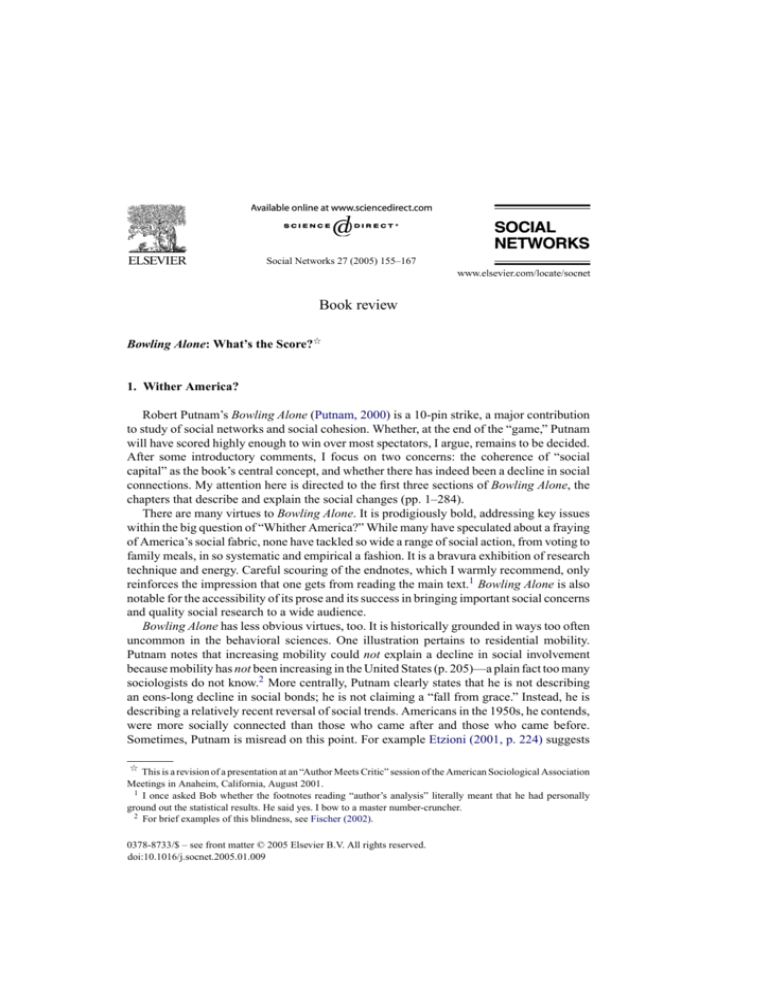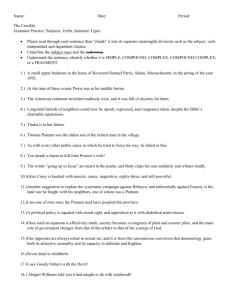
Social Networks 27 (2005) 155–167
Book review
Bowling Alone: What’s the Score?夽
1. Wither America?
Robert Putnam’s Bowling Alone (Putnam, 2000) is a 10-pin strike, a major contribution
to study of social networks and social cohesion. Whether, at the end of the “game,” Putnam
will have scored highly enough to win over most spectators, I argue, remains to be decided.
After some introductory comments, I focus on two concerns: the coherence of “social
capital” as the book’s central concept, and whether there has indeed been a decline in social
connections. My attention here is directed to the first three sections of Bowling Alone, the
chapters that describe and explain the social changes (pp. 1–284).
There are many virtues to Bowling Alone. It is prodigiously bold, addressing key issues
within the big question of “Whither America?” While many have speculated about a fraying
of America’s social fabric, none have tackled so wide a range of social action, from voting to
family meals, in so systematic and empirical a fashion. It is a bravura exhibition of research
technique and energy. Careful scouring of the endnotes, which I warmly recommend, only
reinforces the impression that one gets from reading the main text.1 Bowling Alone is also
notable for the accessibility of its prose and its success in bringing important social concerns
and quality social research to a wide audience.
Bowling Alone has less obvious virtues, too. It is historically grounded in ways too often
uncommon in the behavioral sciences. One illustration pertains to residential mobility.
Putnam notes that increasing mobility could not explain a decline in social involvement
because mobility has not been increasing in the United States (p. 205)—a plain fact too many
sociologists do not know.2 More centrally, Putnam clearly states that he is not describing
an eons-long decline in social bonds; he is not claiming a “fall from grace.” Instead, he is
describing a relatively recent reversal of social trends. Americans in the 1950s, he contends,
were more socially connected than those who came after and those who came before.
Sometimes, Putnam is misread on this point. For example Etzioni (2001, p. 224) suggests
夽 This is a revision of a presentation at an “Author Meets Critic” session of the American Sociological Association
Meetings in Anaheim, California, August 2001.
1 I once asked Bob whether the footnotes reading “author’s analysis” literally meant that he had personally
ground out the statistical results. He said yes. I bow to a master number-cruncher.
2 For brief examples of this blindness, see Fischer (2002).
0378-8733/$ – see front matter © 2005 Elsevier B.V. All rights reserved.
doi:10.1016/j.socnet.2005.01.009
156
Book review
that Putnam’s argument was foretold by Robert Nisbet (in his classic Quest for Community).
Hardly. Nisbet and others in the “mass society” vein described a loss of community exactly in
the era when, Putnam argues, community-ness reached its 20th-century zenith. In such ways,
Bowling Alone rejects simple tradition–modernity formulas in favor of historical accuracy.
Putnam also introduces some useful concepts and observations. For example schmoozer
and macher – terms he uses to describe the difference between people who are merely
sociable and people who are influential – are great additions to our conceptual toolkit
(partly because the more Yiddish, the better). Also, his analysis of television’s pernicious
effects – data-based rather than merely declaimed – is a good corrective to television’s
apologists.3 Finally, Putnam’s ability to resurrect his thesis from its premature burial by his
critics is admirable. To many who followed the debates since the mid-1990s over Putnam’s
initial articles, it seemed that the 2000 Bowling Alone book would be dead on arrival, as
one sociologist predicted to me. Too many of Putnam’s empirical claims, which were based
solely on the General Social Survey (GSS), had been cast in doubt between 1995 and 2000.
Bowling Alone uses the GSS, but not nearly as much as it relies on other longitudinal,
national surveys. By finding large, new datasets and squeezing them dry, Putnam not only
salvaged his argument, but also gained the rhetorical high ground. At the moment, Bowling
Alone is the major statement on “Whither America?”
Enough praise. One definition of “critic” in an “Author Meets Critic” session is faultfinder and I find several faults in Bowling Alone.
There are contradictions. Putnam discusses a few contradictory findings, notably the
data showing that volunteering increased in recent decades. But some contradictions he
reveals only in the endnotes;4 others are evident but are not fully confronted even there.
For example Putnam acknowledges that attendance rates at public events, such as spectator
sports, have increased. He dismisses this as evidence of increased sociability, because, says
he, doing sports is better than watching sports. But exercise is not the question at hand. Public
attendance at sports is public participation and is overwhelmingly done in the company
of family and friends.5 A more significant example concerns crime, which researchers
(including Putnam) typically treat as an indicator of low “social capital.” Rising crime rates
from about 1965 to 1990 reinforce the description of social disintegration. However, after
about 1990 – and in some data, even before – crime rates dropped significantly.6 Such
evidence contradicts the story line in Bowling Alone.
Putnam must also be faulted for some rhetorical overkill (e.g. pp. 39, 43). For example
he describes a change, say from 10 to 8% in some activity, as a formidable “twenty percent”
decline, when it really is a two-point and perhaps marginally significant decline. Elsewhere,
he downplays similar variations if they are in the opposite direction. For example a 30%
increase in volunteering among 20–29 year olds is labeled as “modest” (p. 129), when
elsewhere such changes are described as major.
3
One response (Norris, 1996) is not persuasive because it simply shows that news-watchers are civic.
E.g., p. 110 vs. p. 460n.48; p. 142 vs. p.468n.29; p. 190 vs. p.474n.2, 3.
5 Fair disclosure: my family shares season tickets to the San Francisco Giants.
6 The 1990s drop in FBI crime statistics is well known. Victimization surveys suggest a longer trend on declining
crime rates, since the early 1980s. See e.g. the Statistical Abstract 1999 and 1995. Putnam (p. 144) notes but
downplays the drop in crime.
4
Book review
157
There are conceptual missteps as well. Notably, Putnam has further popularized that
dreadful metaphor, “social capital.” Aside from the substantive issues around that term
which I discuss below, the phrase itself is a problem. It is a metaphor that misleads: Where
can I borrow social capital? What is the going interest rate? Can I move some of my social
capital off-shore?
Putnam says that “social capital refers to connections among individuals—social networks and the norms of reciprocity and trustworthiness that arise from them” (p. 19). The
reason he needs to re-label perfectly usable terms, such as networks and norms of reciprocity,
into a “capital” is “that social networks have value . . . (they) can affect the productivity of
individuals and groups.” Hold on. First, the assumption that the trust norms are part of a
package with networks remains to be established (see below). Second, many things people
have affect their productivity, from good looks to good luck. Shall all these be labeled a
“capital?” If yes, to what use? Third, some networks and social norms often detract from
productivity—bad friends and obligations to elderly parents or grasping relatives, for examples. (Shall we call all these “social liabilities?”) The Oxford English Dictionary’s closest
definition of capital to Putnam’s use of the term is “wealth in any form used to help in producing more wealth.” Are social ties and warm feelings used to produce financial wealth?
Or to produce more social ties and warm feelings or something else? Do they do so? Alas,
this metaphor casts more confusion than light.
“Social capital” is also unnecessary, because clearer and simpler terms – such as membership, family, sociability and trust – serve perfectly well. Putnam implicitly recognizes
the problem when he switches to other metaphors to describe types of “social capital”:
“bridging” and “bonding.” These are both terms much more suited to modify the metaphor
of “ties” than that of capital. “Social capitalism” has expanded in all directions like a swamp
in wet weather. Glaeser et al. (2000, p. 3), for example write that “individual social capital
(is) a person’s social characteristics – including social skills, charisma, and the size of his
Rolodex – which enables him to reap market and non-market returns from interactions with
others.” This is not much different from saying that social capital is everything psychological
and sociological about a person.7
“Social capital” has become one of the many species of “capitals” that have recently
infested sociologists’ prose (see the discussion in, e.g. Portes, 1998; Woolcock, 1998).
Using them lets sociologists play in the same sandbox as economists; they have their kinds
of capital and we have ours. And using the phrase probably allows sociologists more access
to the ears and wallets of the powers-that-be than simply writing about, say, friendship
and church attendance. On the other hand, the term has reciprocally allowed economists
to colonize sociologists’ topics. Now many of them are writing about neighborhood gettogethers, PTAs, Bible-study classes, and the like (e.g. Glaeser et al., 2000; Costa and Kahn,
2001; Alesina and La Ferrara, 2000). This is not necessarily a good thing.
In the end, however, these faults are minor when compared to the achievement that is
Bowling Alone. This review is devoted mainly to two big questions: (1) is there a thing such
as so-called “social capital”? (2) Has this thing declined and, if so, has it declined for the
7 These complaints are some of the reasons that, as past-editor of the American Sociological Association’s
popular sociology magazine, Contexts, I put “social capital” on the do-not-use style-sheet (unless put into ironic
quotation marks).
158
Book review
reasons Putnam gives? Obviously, to fully answer these questions would require re-doing
Bowling Alone itself. I merely raise some considerations.
2. Does “Social Capital” exist?
Bowling Alone analyzes a vast range of individual behavior, including voting, belonging
to sororities, church outings, playing bridge, having family dinners, do-good volunteering,
and professing one’s faith in one’s fellow humans to a pollster, not to mention league
bowling. All of these are elements of so-called “social capital.” Are these really all of a
kind? If not, what different things have been squeezed under this single rubric?
If these behaviors all reflected some underlying property of individuals – personal tendencies toward social connectedness and commitment – then we would expect people who
generally do one behavior to also generally do another. But they do not. For example
researchers have identified voting as a distinct practice from other sorts of political participation or “social capital.” To take a case in point: The Pew Center’s study of trust found that
trusting and distrusting survey respondents voted at about the same rate (Pew Center, 2000:
Table 3; see also Durlauf, 2002).8 Similarly, Putnam and his critics agree that volunteering
seems to show a different pattern than other forms of social participation; volunteering was
increasing in the last couple of decades (Ch. 7; Greeley, 1997; Wuthnow, 1997; Ladd, 1999;
Costa and Kahn, 2001, report no real trend).
I briefly tested the assumption of “social capital” coherence in a quarter-decade of GSS
surveys. (This exercise is reported in Appendix A.) I took seven presumed indicators –
trusting most people, voting, church attendance, belonging to organizations, socializing
with neighbors, socializing with friends outside the neighborhood, and giving money to
charity – and asked whether respondents who reported doing one tended to also report
doing another. The answer is: not really. The strongest association is between reported
church attendance and reported membership in organizations (r = 0.27). Some items are
unrelated, such as voting and getting together with neighbors (r = −0.01). As to “norms of
. . . trustworthiness that arise from (social networks)” (p. 19), the correlations of trust with
seeing neighbors and friends are about zero (Appendix A). If one used such items to create
a “social capital” scale for individuals, it would be a very poor one by typical standards.9
Maybe these attributes are components of the same thing in a different sense. Instead
of being parallel expressions of personal “social capital,” perhaps they are “assets” in people’s social “portfolios,” that is, different kinds of “capital stock.” Some people “invest”
in churches, some in political campaigns, some in family dinners, and yet others in being
trusting souls. If people invest differently – I do friends, you do volunteering, she does
churches – then we would not expect high correlations among these activities. In real financial portfolios, however, people who have more of one asset tend also to have more
8 Some examples of other sorts of studies that separate voting from other dimensions of “social capital,” including
civic participation, are Inglehart (1997), Altschuler and Blumin (2000), and Kaufman (1999).
9 Brehm and Rahn (1997) report mutual effects of trust and organizational membership. It is true that each affects
the other, but not more than do other variables and not at the levels one would expect if trust and membership were
components of the same “thing.”
Book review
159
of another. Anyway, this is not how Putnam describes or uses “social capital,” although it
would fit the metaphor better (see Glaeser et al., 2000).
Although we can stipulate for the moment that the great majority of Putnam’s indicators
have moved in the same direction over the last quarter-century, the wholism implicit in the
“social capital” concept is not persuasive. We could start to suspect that a few different
things, perhaps mutually influencing one another, are involved.
One thing, for example is political. Expressions of political distrust have increased substantially, as have other signs of political alienation, such as disinterest in the news and
declining turnout. The sources of this change may well lie in the body politic itself.10
Another thing is personal sociability, being connected to kin and friends. The trends here,
unlike those regarding politics, are weak and mixed – e.g. less entertaining at home, yet
more personal phone calls – but perhaps real. Their source may lie in the time pressures of
the last few decades and women’s increasing hours away from the home. Thus, Costa and
Kahn (2001), who report using the same data as Putnam, conclude that the only personal
sociability trend of significance is a decline in entertaining at home, which they largely
attribute to women’s increasing work.
Yet another thing is organizational participation. Here, Wuthnow (1998) makes a persuasive case that civic activity has shifted in form. Instead of participating through the sorts
of bureaucracies exemplified by the Rotary Club, people increasingly participate in ad hoc,
specialized ways, as illustrated by an AIDS walk, beach cleanup, or lobbying campaign.
People can be altruistic individualistically. A nifty illustration of Wuthnow’s (1991) description is the award-winning web site, www.volunteermatch.org, which allows people to
join particular do-gooder activities on a one-time basis and even do “remote volunteering.”
It claimed 1,427,192 referrals to 26,561 organizations as of January 21, 2004. (On the other
hand, this kind of volunteering might be just the sort of Bowling Alone activity that Putnam
is pointing to, doing good outside of a “league.”11 )
More generally, Putnam’s odd lot of behaviors could be organized under at least two
more specific – and more sociological – conceptual canopies. One is the familiar construct
of individualism. It is surprising that Putnam does not acknowledge that much of his subject
matter is what most people call “individualism.” He mentions the term rarely (e.g. p. 82)
and does not include it in the book’s index. Perhaps, individualism is a concept so barnacled
with old debates that it would make Bowling Alone sound like earlier jeremiads. But, is not
most of the book really about Durkheim’s egoism: Americans giving less money to charity,
being less sociable, or being more materialistic? Several topics in Bowling Alone would
be better labeled individualism rather than “social capital” if we define individualism as
social practices that favor individual interests over group interests. Addressing individualism
would place Bowling Alone into a familiar literature, but with a radical departure from
that literature, that individualism actually decreased through most of the 20th century and
increased only after the 1950s when Americans began indulging in “the worship of choice”
(Ehrenhalt, 2000, p. 251).
The second alternative label might be privatism. Even if we stipulate, for the sake of
discussion, that Americans have withdrawn from public activities such as politics and civic
10
11
For an overview, see the collection by Nye et al. (1997).
Point suggested by Michael Hout.
160
Book review
clubs, the question arises as to whether they have withdrawn all the way into their isolated, lonely selves (ultimate individualism), or have withdrawn into a more private world
of family, work, and friends—a story of greater, but still social privatism. This analysis is
consistent with Banfield’s (1958) account of civic abandonment. Civic life in Italian villages suffered, he claimed, not because Italians were individualistic, but because they were
amorally familistic, putting the private group above the public good.12 Between these two
alternatives, Bowling Alone leans toward the individualism argument. Putnam contrasts the
happy picture of a grandfather who, after serving his nation in World War II, belonged to
the Elks, was a church deacon, and bowled in a league to the dismal picture of his grandson
who does little more than commute, work, and watch television—and does so all alone. But
much in Bowling Alone better fits the formulation of a shift from public to private sociality.13
When Putnam concedes that some kinds of social activity – fundamentalist religious
denominations, self-help groups, and “new age” movements, volunteering – have increased,
his trump card is to critique those forms for being inward-looking rather than outwardly
civic-minded. Fundamentalist churches, for example tend to focus on saving members’
souls rather than on civic philanthropy; they engage in “privatized religion” (Ch. 4). Fair
enough, but parochial sociality is quite different than no sociality at all; it is still sociality.
Similarly, Putnam’s distinction between “bridging” and “bonding” types of “social capital”
(better phrased as bridging versus in-bound social networks) reinforces a contrast between
public and private rather than a contrast between social and asocial.
Putnam presents several findings that suggest a decline in all forms of sociality, private
as well as public—lowered church attendance, fewer family meals, less frequent social
entertaining, and so on. On the whole, this evidence is more mixed than his evidence
showing civic withdrawal and is subject to quite different explanations, such as the effects
of time constraints. Take the case of voting. Census surveys asked Americans who were
registered but failed to vote why they had not voted. Between 1980 and 1996, the biggest
change in responses was a leap from 8 to 22% who said “busy/no time.” Answers indicative
of political disenchantment (“not interested” plus “did not like the candidates”) did not
increase, 28 and 29% (United States Bureau of the Census 1998).
Either this public versus private formulation or the individualism formulation better
captures the common issues in the potpourri of behaviors Putnam labels “social capital.”
Moreover, the historical trends concerning these separate domains – politics, organizations,
individualism, and privatism – may be only apparently coincident.
3. Is Bowling Alone true?
Have many forms of sociality declined since about 1970? If so, have they declined
because of the reasons Putnam presents? Many scholars responded to Putnam’s first articles
with a verdict of “case not proven.” Now, given the wealth of data in Bowling Alone, the
burden of proof is on the critics.
12
Banfield and his student, James Q. Wilson, went on to study “public- vs. private-regardingness” (e.g. Wilson
and Banfield, 1964).
13 For some relevant discussions on privatism, see e.g. Seligman (1998), Wientraub (1997), McClay (1995), and
Laslett (1973).
Book review
161
Putnam’s initial and central claim was that membership in civic organizations had declined. This is now one of his weaker assertions. Rates of membership, in a gross sense,
seem not to have declined or to have declined in only a few specific types of organizations.
Part of the Putnam’s original results turned out to be statistical error. Critics noted that the
GSS survey counted not memberships, but types of organizations to which people belonged
(e.g. three veteran’s groups would count only as one type). Morever, a decline in the average number of membership types appeared only once education was held constant—a
controversial procedure, as the trend has been for Americans to complete more grades in
school (see e.g. Nie et al., 1996; Helliwell and Putnam, 1999). Critics also pointed out that
new sorts of groups were not captured by the standard list (e.g. Cohen, 1999; Ammerman,
1997; Baumgartner and Walker, 1988 versus Smith, 1990 and following comment). Other
analysts have found that the decline in membership was restricted to only a few types of organizations, notably unions, veterans, and church groups (author’s analysis; see also, Costa
and Kahn, 2001; Wuthnow, 1997; Ladd, 1999; Paxton, 1999).
In Bowling Alone, Putnam essentially shifted his argument (and his data) to focus on
active participation in organizations. The book presents much evidence of a decline in
activities, such as attending political rallies. But volunteering time and labor is up, or at
least steady (e.g., Rotolo, 1999). With respect to politics, researchers have pointed out that
some sorts of political activity, such as writing congressmen and mobilizing neighbors, may
have become more common since the 1960s (e.g. Verba et al., 1995: p. 72; Inglehart, 1997;
Ladd, 1999). Verba et al. (1995: 72), for example, also report an increase between 1967 and
1987 of from 14 to 17% in the percentage of Americans who had “form(ed) a group to help
solve local problems”—an increase in Putnam’s generous metric of “a full” 21%.
In some cases, readers might be skeptical that the size of changes warrants so much
fuss (e.g. Greeley, 2001). For example church membership rates, according to Gallup Polls,
declined from a high of about 75% around 1950 to a roughly stable level of around 68%
since the mid-1970s (Gallup Poll, 2001). This 7-point drop (9% in Putnam’s calculus) over
50 years is well within the sort of error posed by variations in polling procedures, response
rates, and the like—and is largely confined to Catholics.
Finally, a looming issue is the trustworthiness of one of Putnam’s key datasets, the
multi-year DDB Needham marketing poll. Putnam does a good job of defending the data,
but the survey does violate key assumptions in scientific polling, resting on a sample of
respondents who represent 5% of those approached. Many of Putnam’s strongest claims
depend on that data.
Another contention of critics is that Putnam has failed to consider other sorts, perhaps
better sorts, of measures of “social capital,” especially informal associations and new organizational inventions, such as support groups—forms of “social capital” that may have
increased in recent decades.14 Some critics suggest that the very nature of civic and political
participation has changed. It has become more diffuse, in ways that are real and effective,
but poorly measured in the standard surveys (e.g. Schudson, 1998). The Howard Dean
campaign, informally organized through the Internet, is a good example. Personal relations
also may have evolved – not eroded – in ways not captured by the standard measures (e.g.
Starr, 2000). For example social ties at work may have become relatively more important,
14
For example Wuthnow (1991, 1998); although Putnam has a thorough response in Bowling Alone.
162
Book review
especially with women working more. (Putnam notes the point about work but reports that
there is no evidence that work ties have increased or decreased in recent decades; pp. 85ff.)
This line of argument contends that social connectedness has changed rather than declined.
We still await empirical support for the argument.
If we grant the descriptive claims in Bowling Alone, that Americans are participating less
in many forms of social and civic activity, the next questions arise about the explanations
that Putnam proffers. He places greatest weight on generational succession because most of
the survey data show big differences between successive generations but smaller differences
between time periods for any particular generation.15 Putnam argues that some part of the
generational differences is the product of being raised with television. He attributes lesser
causal effect to increased work and commuting hours.
Yet, Bowling Alone probably underestimates the importance of work pressures and of
women’s increasing participation in the paid labor force (see, e.g. Costa and Kahn, 2001).
After all, much of what the book discusses are precisely time-consuming activities. As
individual and family time demands accumulate – such as commuting, which Putnam does
focus on, but also work hours and child care – something has to give, although neither
attention to children nor religion seem to be one of those.16
The increasing preoccupation of women with work surely accounts for much of the
strains on voluntary associations. Putnam argues that women’s participation in the labor
force cannot be a major explanation for declining civic participation because the decline is
at least as strong among non-working women. But that argument neglects contextual effects.
As energetic and socially skilled wives get careers, it becomes harder for those women
remaining at home to sustain civic activities. (A principle of most voluntary organizations
is that 10% of the people do at least 90% of the work.) Indeed, employed women might
show lesser decline in their participation because they take their energies into professional
activities and because their professional work can assist their civic work. For example,
some lawyers provide an environmental group with pro bono advice. Those out of the labor
force are left to shoulder much of the voluntary association burden alone – especially in
traditional organizations, such as women’s clubs – and many cannot sustain the effort.
Wuthnow (1998) describes a couple of cases such as this.
While Putnam covers a wide range of explanations, there are others that are insufficiently
explored. For example, two studies suggest that widening inequalities in American society
undermine organizational membership (Alesina and La Ferrara, 2000; Costa and Kahn,
2001). Others point to particular news events and social changes since the mid-1960s for
creating both political withdrawal and a general sense of malaise. Scandals, crises, and political difficulties – together with their close coverage by the media – may well explain much
of Americans’ disenchantment with politics (see e.g. Paxton, 1999; Kleppner, 1982; King,
1997; Nye and Zelikow, 1997). Americans’ recent distrust of politics may simply reflect
15
For example in the case of trust (p. 141).
On increased work hours, see Jacobs and Gerson (1998). Although the issue is contested, most authorities
believe that total work time – at least among two-job American couples in the prime working years – has increased.
On some of the consequences, see Family and Work Institute (1999) and Bianchi et al. (2000). Bianchi (2000)
reports that parent–child contact, however, did not decline in the last couple of decades. Fischer et al. (2000) find
limited effects of family time pressures on church membership or attendance.
16
Book review
163
what they have recently learned about politics. Similarly, Americans may have become
more anxious and distrusting since the 1950s because their social milieus have become
more frightful. For example Americans’ answers to the questions about distrusting “people” track closely with the national homicide rate and personal experiences of crime (Pew
Center, 2000: Fig. 6; Smith, 1997; see also Mansbridge, 1997; Lipset, 1995). These alternative explanations – ones that point to time constraints, or political events, or particular
social changes – differ from Putnam’s. First, they are topic-specific, and second, they link
concrete events to changes in individual behavior instead of positing a global change in a
diffuse quality such as civic-mindedness or sociability.
The diffuseness of Putnam’s favored explanation – generational change – is another problem. To say that generational turnover – or historical time – “explains” something is not
really to explain but to label. What about different generations would lead those who are now
senior citizens to be highly civic-minded and their children to be much less so? Television
provides a partial answer: Perhaps because baby-boomers were the first to grow up watching
television that habit permanently sapped their social energies. The television argument gains
special persuasiveness because a variety of evidence – not just survey–data correlations,
but also observational studies, experiments, and individual-level and community-level longitudinal studies – all point to the anti-social effects of television-watching (e.g. Williams,
1986; Kubey and Csikszentmihalyi, 1990; Wartella and Mazzarella, 1990).
Beyond television, the generational explanation is vague and weakly supported. Putnam
devotes considerable space to arguing that World War II instilled an esprit de corps in the
“Greatest Generation,” but the evidence for that is largely impressionistic (pp. 267ff). One
could tell a similar story of how the shared experience of overcrowded schools, political
traumas in the 1960s, and the efflorescence of youth culture bonded a generation that danced
together in the streets to the beat of Motown. Yet that would describe the “Worst Generation.” In truth, the source of the generational differences – the special civic mindedness
of Americans born between 1910 and 1940 – remains mysterious. Another quirk in the
explanation is that Bowling Alone attributes the high participation level of Americans born
between 1910 and 1940 largely to their adult experiences, the war, but the low participation
level of the Baby Boomers largely to their childhood experiences, watching television.
Perhaps what we have in the generational differences is some sort of long-term cyclical
pattern. Some ideas and customs – just like some organizations – wax and wane. For example in the 1920s, the Rotary was an exciting break with the stodgy old men’s fraternities
like the Moose; in the 1970s, spiritual exploration was an exciting break with the stodgy
old men’s clubs like the Rotary. Maybe, cultural patterns expand until they break of their
own weight, giving way to something new. If so, perhaps the social unraveling Putnam
describes has run its course. Here and there in Bowling Alone, Putnam notes hopeful new
signs, such as increasing volunteering (see also Putnam, 2002). Other signs are there, too.
For example crime is down almost to levels of the 1960s; trust in government rebounded in
the 1990s (Moore, 2000; Nie et al., 1996; Pew Center, 2000); early teen sexual experimentation declined (Lindberg et al., 2000); and new forms of social connections, some aided
by technology, emerged. Maybe the wheel is about to turn again. Perhaps even stylized responses to surveys will shift from the ironic and cynical back toward the more pollyannaish
self-presentations of the 1950s. Robert Putnam may have founded a movement for more
civic-mindedness just as Americans were moving that way on their own accord.
164
Book review
4. Keeping score
These criticisms should not detract from the great accomplishment that Bowling Alone
is. Putnam has racked up a high score and many social scientists will be busy in the next
several years playing catch-up. He has mightily contributed an impressive catalog of welldocumented social changes and a set of provocative ideas about those changes. Whether
Putnam has accurately interpreted the changes or explained them is more questionable. My
major debates with Bowling Alone involve:
• objecting to “social capital,” both as terminology and as concept;
• suggesting that we would get more theoretical traction by thinking about individualism
and privatism than about “social capital”;
• observing that disaggregating the topics now lumped together under “social capital”
would also yield a better empirical understanding of what has been going on. The contradictions in data and trends might be better resolved by seeing the social changes as
roughly coincident but different phenomena;
• noting limits in the persuasiveness of the generational explanation and the promising
possibilities of turning to other explanations;
• expecting that new research – so much stimulated by Robert Putnam – will revise the
claims in Bowling Alone.
That is for the future. For now, Bowling Alone is the prime reference on “Whither
America?”
Acknowledgements
Michael Hout helped improve the earlier draft, and Barry Wellman and Beverly Wellman
helped edit the talk into a publication.
Appendix A. Exploring the intercorrelations among “Social Capital” items
The following reports a modest exercise in assessing whether elements of Putnam’s
“social capital” cohere in a fashion one would expect if they all indicated a global property
of individuals. The data are the 1972–2000 General Social Surveys.
I took seven measures:
(1) Trust: whether the respondent reported trusting “most” people (three-point scale).
(2) Voted: whether the respondent reported voting in the previous presidential election
(no/yes).
(3) Attendance: reported frequency of attendance at church services (7-point scale).
(4) Organizations: the number of organization types the respondent reported belonging to
(0–4 or more—the famous NUMMEM scale).
(5) Neighbors: respondents’ reports of how often they got together with neighbors (7-point
scale).
Book review
165
(6) Friends: respondents’ reports of how often they got together with friends outside the
neighborhood (7-point scale).
(7) Giving: how many types of organizations, out of 13 (including informal giving and
“other” giving), the respondent reported giving money to in 1995 (0–4 or more; available
only for the 1996 GSS).
The zero-order correlations among them are:
Trust
Trust
Voted
Attendance
Organizations
Neighbors
Friends
Voted
Attendance
Organizations
Neighbors
Friends
Giving
0.18
0.04
0.18
0.18
0.27
0.27
0.02
−0.01
0.04
0.10
0.05
−0.02
−0.00
0.15
0.20
0.18
0.23
0.19
n/a
0.04
0.05
The partial correlations among them controlling for age, education, marital status, and
race are:
Trust
Trust
Voted
Attendance
Organizations
Neighbors
Friends
Voted
Attendance
Organizations
Neighbors
Friends
Giving
0.10
0.03
0.13
0.09
0.18
0.27
0.04
0.03
0.07
0.12
0.05
0.05
0.06
0.13
0.18
0.08
0.11
0.17
n/a
0.05
0.08
The controls do little to improve the picture of quite modest associations for items meant
to all indicate one thing.
This is, of course, only a quick look, not an in-depth analysis. But if the “social capital” concept presumes a tight interconnection among its various elements, that does not
immediately appear in the data.
References
Alesina, A., La Ferrara, E., 2000. Participation in Heterogeneous Communities. Quarterly Journal of Economics
115 (August), 847–904.
Altschuler, G.C., Blumin, S.M., 2000. Rude Republic: Americans and Their Politics in the Nineteenth Century.
Princeton University Press, Princeton, NJ.
Ammerman, N.T., 1997. Organized religion in a voluntaristic society. Sociology of Religion 58 (Fall), 203–216.
Banfield, E.C., 1958. The Moral Basis of a Backward Society. Free Press, New York.
Baumgartner, F.R., Walker, J.L., 1988. Survey research and membership in voluntary associations. American
Journal of Political Science 32 (November), 908–928.
Bianchi, S.M., 2000. Maternal employment and time with children: Dramatic change or surprising continuity?
Demography 37 (November), 401–414.
Bianchi, S.M., Milkie, M.A., Sayer, L.C., Robinson, J.P., 2000. Is anyone doing the housework? Trends in the
gender division of household labor. Social Forces 79 (September), 191–228.
166
Book review
Brehm, J., Rahn, W., 1997. Individual-level evidence for the causes and consequences of social capital. American
Journal of Political Science 41 (July), 999–1024.
Cohen, J., 1999. Does voluntary association make democracy work? In: Smelser, N.J., Alexander, J.C. (Eds.),
Diversity and Its Discontents: Cultural Conflict and Common Ground in Contemporary American Society.
Princeton University Press, Princeton, pp. 263–292.
Costa, D.L., Kahn, M.E., 2001. Understanding the Decline in Social Capital, 1952–1998. Working Paper No.
8295. Cambridge, MA: National Bureau for Economic Research.
Durlauf, S.M., 2002. Bowling Alone: A review essay. Journal of Economic Behavior and Organization 47 (March),
259–273.
Ehrenhalt, A., 2000. The lost city: The case for social authority. In: Eberly, D.E. (Ed.), The Essential Civil Society
Reader: The Classic Essays. Rowman & Littlefield, Lanham, MD, pp. 239–255.
Etzioni, A., 2001. Is bowling together sociologically lite? Contemporary Sociology 30 (May), 223–
224.
Families and Work Institute, 1999. The 1997 National Study of the Changing Workforce. http://www.
familiesandworkinst.org.
Fischer, C.S., 2002. Ever-more rooted Americans. City and Community 1 (June), 175–194.
Fischer, C.S., Hout, M., Latham, N., 2000. The Time Bind and God’s Time. Working Paper, USA: A Century of
Difference Project, University of California, Berkeley (http://ucdata.berkeley.edu/rsfcensus).
Gallup, P., 2001. Topics A–Z: Religion. http://www.gallup.com (Accessed 4 April).
Glaeser, E.L., Laibson, D., Sacerdote, B., 2000. The Economic Approach to Social Capital. Working Paper No.
7728. Cambridge, MA: National Bureau of Economic Research.
Greeley, A., 1997. The other civic America. The American Prospect 32 (May–June), 68–73.
Greeley, A., 2001. Professor Putnam’s Hour and a Half. Unpublished paper, courtesy of author (July).
Helliwell, J.F., Putnam, R.D., 1999. Education and Social Capital. NBER Working Paper No. W7121. Cambridge,
MA: National Bureau of Economic Research.
Inglehart, R., 1997. Postmaterialist values and the erosion of institutional authority. In: Nye Jr., J.S., Zelikow,
P.D., King, D.C. (Eds.), Why People Don’t Trust Government. Harvard University Press, Cambridge, MA, pp.
217–236.
Jacobs, J.A., Gerson, K., 1998. Who are the overworked Americans? Review of Social Economy 56 (Winter),
442–459.
Kaufman, J., 1999. Three views of associationalism in 19th-Century America: An empirical examination. American
Journal of Sociology 104 (March), 1296–1345.
King, D.C., 1997. The polarization of American parties and mistrust of government. In: Nye Jr., J.S., Zelikow,
P.D., King, D.C. (Eds.), Why People Don’t Trust Government. Harvard University Press, Cambridge, MA, pp.
155–178.
Kleppner, P., 1982. Who Voted? The Dynamics of Electoral Turnout, 1870–1980. Praeger, New York.
Kubey, R., Csikszentmihalyi, M., 1990. Television and the Quality of Life: How Viewing Shapes Everyday
Experience. Lawrence Erlbaum, Hillsdale, NJ.
Ladd, E.C., 1999. The Ladd Report. Free Press, New York.
Laslett, B., 1973. The family as a public and private institution. Journal of Marriage and the Family 35 (August),
48–92.
Lindberg, L.D., Boggess, S., Porter, L., Williams, S., 2000. Teen Risk-Taking: A Statistical Portrait. The Urban
Institute, Washington.
Lipset, S.M., 1995. Malaise and resiliency in America. Journal of Democracy 6 (July), 4–18.
Mansbridge, J., 1997. Social and cultural causes of dissatisfaction with U.S. Government. In: Nye Jr., J.S., Zelikow,
P.D., King, D.C. (Eds.), Why People Don’t Trust Government. Harvard University Press, Cambridge, MA, pp.
133–154.
McClay, W.M., 1995. Where have we come since the 1950s? Thoughts on materialism and the American social
character. In: Wuthnow, R. (Ed.), Rethinking Materialism: Perspectives on the Spiritual Dimension of Economic
Behavior. William B. Erdmans, Grand Rapids, MI, pp. 25–71.
Moore, D.W., 2000. Americans Express Positive Views About Government and Political Leaders. Gallup News
Service, On-line: http://www.gallup.com.
Nie, N.H., Junn, J., Stehlik-Barry, K., 1996. Education and Democratic Citizenship in America. University of
Chicago Press, Chicago.
Book review
167
Norris, P., 1996. Does television erode social capital? A reply to Putnam. PS: Political Science & Politics 29
(September), 474–481.
Nye Jr., J.S., Zelikow, P.D., King, D.C. (Eds.), 1997. Why People Don’t Trust Government. Harvard University
Press, Cambridge, MA.
Nye Jr., J.S., Zelikow, P.D., 1997. Conclusions: reflections, conjectures, and puzzles. In: Nye Jr., J.S., Zelikow,
P.D., King, D.C. (Eds.), Why People Don’t Trust Government. Harvard University Press, Cambridge, MA, pp.
253–281.
Paxton, P., 1999. Is social capital declining in the United States? A multiple indicator assessment. American
Journal of Sociology 105 (July), 88–127.
Pew Center 2000. Deconstructing Distrust: How Americans View Government. On-line: http://pewpeoplepress.org-trustrpt.html (Accessed: 2 May 2000).
Portes, A., 1998. Social capital: Its origins and applications in sociology. Annual Review of Sociology 24, 1–24.
Putnam, R.D., 2000. Bowling Alone: The Collapse and Revival of American Community. Simon & Schuster, New
York.
Putnam, R.D., 2002. Bowling together. The American Prospect (February), 20–22.
Rotolo, T., 1999. Trends in voluntary association participation. Nonprofit and Voluntary Sector Quarterly 28 (June),
199–212.
Schudson, M., 1998. The Good Citizen: A History of American Civic Life. Free Press, New York.
Seligman, A.B., 1998. Between public and private. Society 35 (March/April), 28–36.
Smith, T.W., 1990. Trends in voluntary group membership: Comments on Baumgartner and Walker. American
Journal of Political Science 34 (August), 646–661.
Smith, T.W., 1997. Factors relating to misanthropy in contemporary American society. Social Science Research
26 (June), 170–196.
Starr, P., 2000. The public vanishes — Bowling Alone: The Collapse and Revival of American Community. New
Republic (August), 35.
United States Bureau of the Census, 1998. ‘Too Busy’ to Vote. Census Brief. Washington: U.S.G.P.O.
Verba, S., Sclozman, K.L., Brady, H.E., 1995. Voice and Equality: Civic Voluntarism in American Politics. Harvard
University Press, Cambridge, MA.
Wartella, E., Mazzarella, S., 1990. A historical comparison of children’s use of leisure time. In: Butsch, R. (Ed.),
For Fun and Profit: The Transformation of Leisure into Consumption. Temple University Press, Philadelphia,
pp. 173–194.
Wientraub, J., 1997. The theory and politics of the public/private distinction. In: Weintraub, J., Kumar, K. (Eds.),
Public and Private in Thought and Practice: Perspectives on a Grand Dichotomy. University of Chicago Press,
Chicago, pp. 1–42.
Williams, T.M. (Ed.), 1986. The Impact of Television: A National Experiment in Three Communities. Academic,
Orlando, FL.
Wilson, J.Q., Banfield, E.C., 1964. Public-regardingness as a value premise in voting behavior. American Political
Science Review 58 (December), 876–887.
Woolcock, M., 1998. Social capital and economic development: Toward a theoretical synthesis and policy framework. Theory and Society 27, 151–208.
Wuthnow, R., 1991. Acts of Compassion: Caring for Others and Helping Ourselves. Princeton University Press,
Princeton, NJ.
Wuthnow, R., 1997. The Changing Character of Social Capital in the United States. Unpublished paper, Princeton
University.
Wuthnow, R., 1998. Loose Connections: Joining Together in America’s Fragmented Communities. Harvard University Press, Cambridge, MA.
C.S. Fischer∗
University of California, Department of Sociology
402 Barrows Hall, 94720-1980, USA
∗ Tel.: +1 510 642 4766; fax: +1 510 642 0659
E-mail address: fischer1@berkeley.edu







